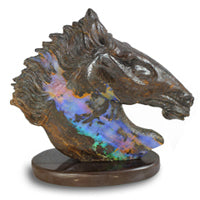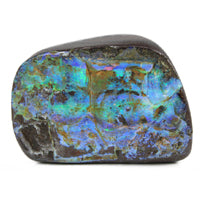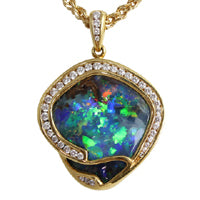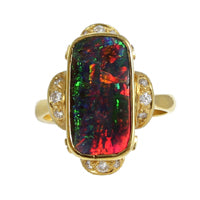About Opals
What is Opal
The word “Opal” is from the Greek "Opallos" meaning to "see a change of colour”. Each opal has different colours, shape and size. When rotated, the Opal displays constantly changing spectacular colours.

|
 |
 |
Value of Opals
Opals are unique, no two Opals are ever the same. Because of its rarity, some fine quality Opals can command prices similar to the finest emeralds, rubies and diamonds.

|
 |
 |
Where does Opal come from?
Opal is Australia’s National Gemstone.

More than 90% of the world's precious opals come from the Great Desert regions of Central Australia.
In Australia, the major commercial mining locations are Lightning Ridge, Coober Pedy and the Queensland Fields. The opal mining fields of Australia are in the harsh outback where only the tough miners can make a living.
Lightning Ridge (Black Opals, Crystal Opals)
The town has a population of around 6,000 and it is the home of the world famous Black Opals (Dark Opals) and has continued to supply the highest quality Black and Crystal Opals since the early 1900s.
Coober Pedy (White Opals, Crystal Opals)
Coober Pedy in South Australia has a population of 4,000 and produces Light (White and Crystal) Opals. Because of extremely harsh environment it's famous for underground living. The name Coober Pedy is an Aboriginal name meaning “white man in a hole”.
Queensland Fields (Boulder Opals)
The Queensland Fields produce Boulder Opal which forms in veins in the ironstone host rock. The fields are situated in semi-desert regions and are scattered over hundreds of kilometers. The opal is mined mostly by open cutting with bulldozers.
The other sources of Opals are Mexico, Brazil, Indonesia Czech Republic and the USA.
How Opal is formed?
Back in prehistoric times, around 65 – 140 million years ago, central Australia was an inland sea. The evidence that Australia used to have an inland sea is that many fossils of shells and fish bones have been found from inland of Australia. Fine marine sands rich in silica were deposited around the shoreline.
Around 30 million years ago, lots of silica gel was released into a solution which filled cracks in the rocks, nature’s intense heat and moulding processes then hardened the gel and formed precious Opals. It takes about 5 to 6 million years for an Opal to form 1 centimetre thick. Some fossils of sea shells and fish bones have also been replaced with Opal.
Opal is formed from tiny spheres of transparent hard silica and the spheres determine colours and patterns of Opals. The variation of colours come from the size of spheres. Smaller spheres create blues, larger spheres create reds. More uniformed spheres create more intense, brilliant and defined colour.
Opal is non-crystalline silica (similar to quartz), combined with water. Opals consist of 3% to 10% of water. Other gemstones like diamond, sapphire or ruby are formed crystalline.
Myth and History of Opals
The word Opal comes from the Latin Opalus which means "precious jewel."
Opal is not only one of the world's most beautiful precious gemstones, it is also one of the worlds rarest. Opals rarity has made it desirable especially among the nobles.
In ancient times, Opal has been a favorable gem for imperials and royal families of European countries. One of the famous generals during the Roman Empire, Marcus Antonius was going to give a beautiful opal to Cleopatra. But that stone was owned by Nonius, a Roman politician and he denied to sell the stone to Antonius. Antonius got angry with Nonius and banished him out of Rome.
French Emperor Napoleon gave to his wife Josephine an opal called “The Burning of Troy” because of its strong play of colors.
In England, Queen Victoria loved this precious gem and always wore opal jewellery. Because Australia has been the colony of England, English Royal family owns many high quality opals now.
The Arabs believed that Opals fell from the sky and the Orientals referred to them as “the anchor of hope”.
Opal Birthstone
October's birthstone Opal symbolizes faithfulness and confidence. Throughout history, the gem has been regarded as the stone of good fortune and it was believed Opals possessed magical power.
